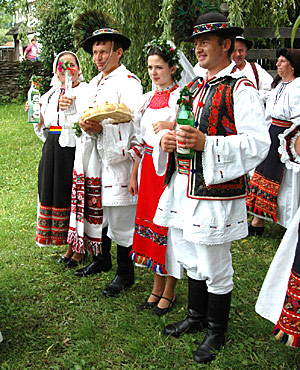Maramures – Traditions
Maramureş, here with  the meaning of the vast historical Country of Maramureş, is considered one of the best preserved zones in Europe from the perspective of cultural anthropology and ethnography.
the meaning of the vast historical Country of Maramureş, is considered one of the best preserved zones in Europe from the perspective of cultural anthropology and ethnography.
Pictures Traditions and Customs in Maramures
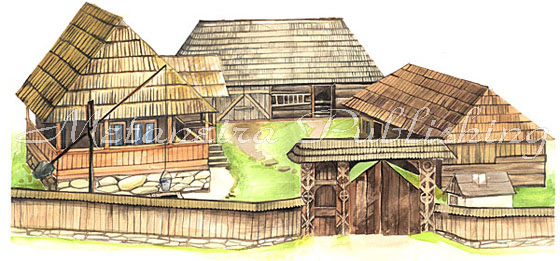
All photos and illustrations are taken from the Maramures travel guide where they can be seen in high quality.
Summary: Old traditions have remained alive due to the high mountains sheltering the long depression from all sides.
Moroşenii, as the people of Maramureş call themselves, are a hospitable people who like company and talking. The old habit of greeting everyone, originating from the times when people of the same community were few and the strangers even fewer, continues today: when two people meet they greet each other, be they acquaintances or complete strangers.
Maramureş is one of the few zones where the folk costume has been preserved almost unaltered by urban influences. And although it can be admired only on Sundays when Moroşenii go to church, or on the occasion of religious feasts and great fairs, each Moroşan, without exception, owns a traditional costume. Not only old people dress in traditional clothes but also “coconii” (preschool children), which explains the continued use of the costume.
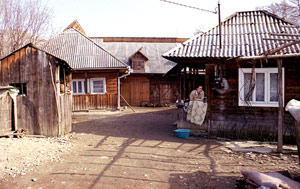
Anyone entering Maramureş from the east, through the Prislop Pass that separates the Maramureş Mountains from the Rodnei Mountains, can immediately notice the defining feature of Maramureşean settlements. The villages are big, often quite compact, with houses lining the road that follows the river valley. Usually, there are two or even three houses aligned in the narrow and long plot of land owned by the family in question. This way of building is an indication of the age of the site, with less and less space for each successive generation.
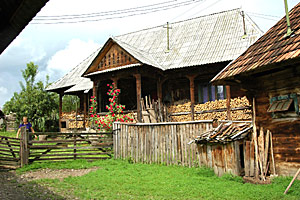
A traditional village farmyard in Maramureş typically includes several buildings. The main house is placed either opposite the entrance gate or perpendicular to it, but in a way that the main façade is either towards south or east. The largest building in the yard is the combined barn and stable, where the horses and cows are housed. One or more small buildings are often found near the fence to house the smaller farm animals, pigs and poultry.
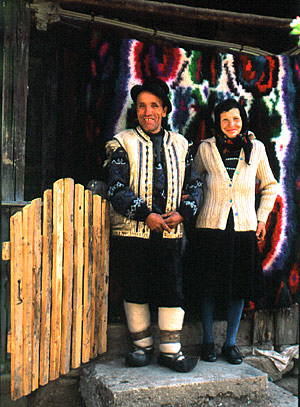
Both women’s and men’s costume includes a bag made of woollen loom-woven textile, most often of chequered pattern. The pattern can be chromatically rich or plain black and white that is often adorned with geometric motifs, the rhomboid being the most frequent. A lace twisted of woollen yarn serves at binding the mouth of the bag and at wearing it on the shoulder. It is interesting that this item of the traditional costume was also adopted for use with daily clothes: blue jeans, T-shirt, leather coat and a bag on the shoulder is a common sight.
The women’s folk costume of Lăpuş includes a shirt folded around the neck with a small collar and sleeves that end in a flounce and lace. A sleeveless vest is worn in the cold season. In the 19th century it was usually white but in the 20th century black became the favourite colour. Floral embroideries are made with red, orange, green and violet silk.
Girls and unmarried women wear their hair plaited and covered with a scarf. On festive days the plaits are decorated with ribbons and flowers. A married woman pins her hair up and covers it with a scarf. On festive days the plaits are decorated with ribbons and flowers. A married woman pins her hair up and covers it with a scarf. Men’s costume doesn’t differ much from that of Maramureş.
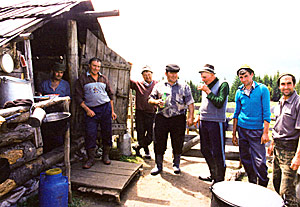
The relationships between humans in general, but especially those between members of different communities, have been carried out through an archaic commercial practice, very active even nowadays: the fair. Generally speaking, the fair is a market where people from the villages of a very well defined come to sell and/or to buy various goods. When a business agreement is reached, the “adălmaş” is drunk, a glass of horincă, as a symbol of the common agreement. It should be mentioned that Moroşenii do not even nowadays use any papers to back up their commercial agreements, their word and honour binding them.
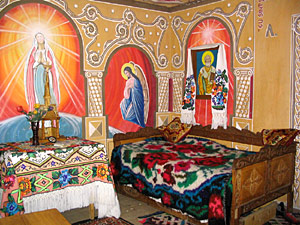
The living room, which the Moroşan calls casa (house), is the domestic universe and arranged according to the aesthetic and pragmatic taste of women. Women are in charge of the design and division of space in the whole house and they also decorate the dwellings and objects used in daily life. Women are the practitioners of various rituals relating to the transitions of life: birth, marriage and death, and these rituals take place in the house. This ritual space is marked by the presence of holy icons on the walls, together with a display of beautiful ceramic ware adorned with home woven towels.
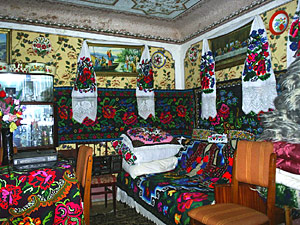
In the corner is a table and along the walls are wide benches that serve as wooden beds, with big bridal chests placed at right angles with them. By the icons, always placed on the east wall, above the table and especially above the master beam, there are hidden papers, the razor for shaving, the cross for the feast of Saint John the Baptist, basil that for the Romanians is a sacred plant with magical and religious powers, placed in wooden boxes. In the bridal chests are kept the blouses, the skirts (zade) and the valuable objects of the girl to marry. The harmony of the interior is completed by the vivid colours of the textiles and of the various objects that adorn it.
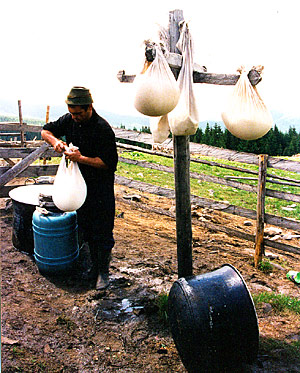
At the fairs the alimentary habits of the Moroşeni are revealed. The food markets are practically invaded by milk products, especially sheep-milk and cow-milk cheese, between May and the end of September, sometimes even later. The soft cottage cheese (with whey) or urdă and the green sheep-milk cheese or caş are eaten all through the warm season. During this period sheep-milk is full of fat due to pasturing on the slopes of the mountains. The herds are taken to the mountain pastures on St. George (26 October) and back to the valleys on St. Demeter (23 April). Making cheese is a way to preserve excess milk for the cold season.
Another staple food of the Maramureşean diet is pork meat. On each farm, one week before Christmas, a pig is slaughtered, an event in which the whole family takes part. After the butchering, the pig is singed, cut to pieces, and various specialities are prepared (sausages, bacon etc.), all smoked to conserve them for the winter.
Maramureşean people are great eaters of onions, garlic, cabbage and potatoes, which are all cultivated in the region. Naturally, daily alimentation varies from one season to another.
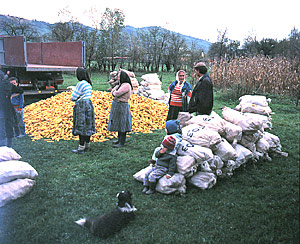
For a long time it was thought that the soil of Maramures was too infertile to support farming at an important scale even during the Middle Ages and that harsh natural conditions necessitated animal husbandry. In reality, old documents tell of agriculture around the villages, and most probably the people got their livelihood combining farming and herding. Especially the lowlands in the river valleys were densely populated, which is a clear indication of the value of good farming land. Already in 1375 a mill is mentioned in Crişăneşti, and another in in 1415 in Şieu. There are also place names that refer to cereal growing and grinding, such as Răul Morii, the Mill River. By the 15th century, the practice of rotation farming between two different crops and fallow periods was well established.
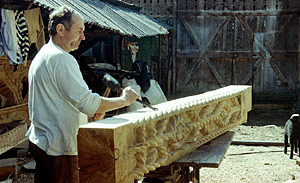
Maramureş is a civilization of wood, made obvious by the splendid wooden churches and the numerous buildings of lay architecture. Even though life in Maramureş is adjusting itself to modern times, some elements are preserved unchanged, which is a proof of a strong collective mentality. Unfortunately, modern construction materials are partly replacing the traditional log-built house, but the church, the Calvary and the gate have remained the same all through the documented periods, as far as material, techniques and symbols are concerned. The best wood meant for building is cut during winter when it is at its strongest.
{tours-banner-scroll}
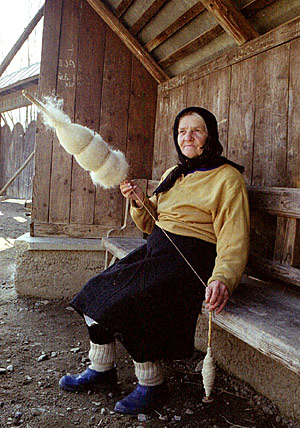
The inhabitants of Maramureş, being animal breeders par excellence, and especially sheep breeders, have preserved until this day the ancient ways of processing textile fibres. The long work of wool processing starts in May, when shepherds shear the herds in their care. The wool is then washed, dried, carded and stored. Once the agricultural season comes to an end with the completion of fieldwork, women start the real processing of wool: spinning the wool with a distaff, then weaving and thickening the cloth in whirlpools. Each woman of Maramureş has in her household a loom, which finds its place in the kitchen during the winters. In Maramureş, the loom is used to make cergi (long-haired blankets), carpets, bags and pănură (thick cloth used to make warm winter clothes: sumane (long winter coats), gube (short winter coats), and trousers.
In most cases the blankets and cloths are dyed with industrial pigments, bought from the market, but bags and carpets are often dyed using old recipes for preparing natural vegetable dyes. Thus, nettle is used to get green colour, birch bark for black, onion for ochre and buckthorn for brown. The decorations vary from area to area.
Weaving and spinning are occupations that only women – and all women – take part in, and a series of ancient beliefs and taboos are still alive today.
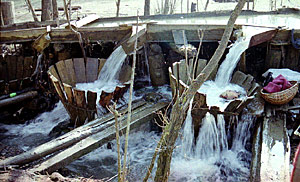
A whirlpool is made with boards that form a loose open barrel the shape of a truncated cone. Water is led into the barrel, whirls around it, and splashes out from the slits between the boards. The centrifugal movement of water spins the fabrics wildly around.
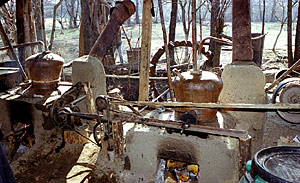
The stills for making horincă are masterpieces of traditional metallurgy. Made of copper beaten with hammer, and then joined perfectly together with rivets, the stills have a capacity varying between 100 and 500 litres. They are equipped with a mixer, whose action depends on a water wheel, to stir the fruit. The still is placed atop an open hearth, where a hot fire is maintained, necessary to the distillation of the fruit to obtain the drink. There are two periods and, implicitly, two types of drink that can be obtained: the horincă made at the end of summer with plums and the apple rachiu made in spring.
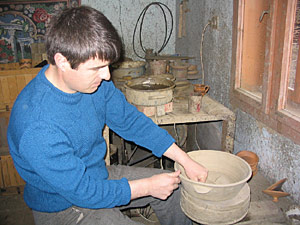
Ceramic ware is still produced and used throughout the region of Maramures. The ware is made in various shapes and sizes, depending on the intended use. The colours are vivid greens, reds and blues on a whitish background.
If one wants to see the only place in Europe where unglazed red ceramic ware is still produced, then they should go to Maramureş, towards the source of Iza River. All steps have been preserved in an unchanged form: the manner of preparing the clay, which is by first treading it with feet and then pounding it with wooden hammers, the shapes of the pots, the preparation of the pigments by grinding rocks containing iron oxides, the polishing with river stones, the painted decorations, the shape of the oven, and the firing techniques.
Pictures Traditions and Customs in Maramures
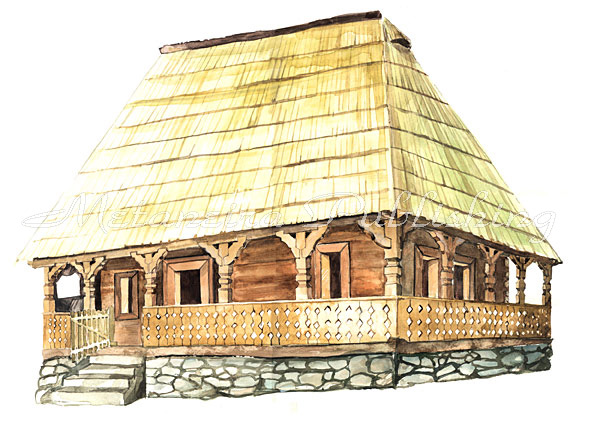

 Mocanita
Mocanita Travel Bucovina
Travel Bucovina Rustic Traditional Houses
Rustic Traditional Houses Oltenia – Traditions
Oltenia – Traditions